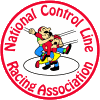- Objective:
It is the purpose of this event to promote the advancement of "Three up"
flying of semi-scale, realistic looking B Team Race control line racing
models, similar to and including those flown throughout the world in
the 1940's, 50's and 60's. These airplanes shall be flown in direct
competition through a series of heat races and a final.
-
All provisions of the AMA Control Line Unified Racing Rules apply except
as listed below.
- Allowable model designs.
Any B team race airplane from the 1940's, '50's, and '60's may be
used. Individual designs that are similar in appearance may also be used.
- Single flying surfaces (ie. flying wing designs), "pod-and-boom" fuselages,
and flush or prone canopies are prohibited. Model shall be attractively
finished or covered, with no all clear finishes allowed. Model shall
have racing numbers in proportion to the model affixed near the top
inboard wing tip and both fueselage sides.
-
There will be an award for best appearance.
In the interest of promoting attractively finished models, should the
best appearing model qualify for the feature race, it shall be given
the first choice of pitting segment.
-
All aspects of model design, construction, and flying, shall be in
keeping with the "Spirit of the event".
- Model specifications.
-
Fiberglass or carbon cloth may be used to strengthen, or cover over wood. No all composite models allowed.
-
Wing area shall be 125 sq. inches. minimum, excluding fillets and the
area covered by the fuselage.
Models which appear to comply need not be further checked, except in
the case of a dispute, where it shall be the contestants responsibility
to provide proof of legality.
-
The fuselage shall measure 2" wide somewhere within a zone located 3/8"
above and below the thrust line, and between the nose of the airplane
and the trailing edge of the wing. However, in the interest of keeping
the appearance of the models similar to those from the '40's, '50's,
and '60's, it is recommended that at the pilots location, the fuselage
measure no less than 2" wide within the area between the pilots shoulders and his hips.
-
Model shall have a cockpit or cabin containing a dummy pilot's head
with both being in proportion to the model. Canopies must be clear
from the back of the pilots head forward to the front of the canopy,
so as to provide forward and lateral vision for the pilot. Canopies
must protrude above the forward fuselage contour with a resemblance
to the "bubble or turtle deck style canopies" employed on full scale
racing aircraft. Open cockpits must have a windscreen.
-
At the pilot's location, the fuselage shall measure a mininum of 3 3/4"
from the top of the canopy, or if open cockpit, from the top for the
pilot's head, to the bottom of the fuselage.
-
The landing gear shall be of the 2 wheel side by side type (ie. separate
struts exiting on either side of the fuselage centerline). Both wheels
shall be no less than 1 1/2" in diameter.
The landing gear shall have a minimum lateral spread measured from
the center of each wheel, of no less than 4".
-
Engines shall be fully cowled and be completely covered. Openings
for the air intake, needle valve stem, fuel shutoff, engine exhaust,
engine cooling ducts, and glow plug access are allowed. In keeping
with the spirit of the event, no helmet cowls (ie. conventional speed
model types) will be allowed. Side mounted engines using a "cheek cowl"
to cover the engine, must have an identical cheek cowl on the opposite
side of the fuselage.
-
Maximum allowable model weight shall be 36oz.
- Engines:
Any single bypass up to .29 cu. in., or any engine up to .28 cu. in.
Full wave tuned pipes are prohibited. Mufflers, or exhaust extensions
which do not increase engine performance will be allowed.
- Fuel:
Fuel shall be the contestants choice. Any substance banned by the AMA
will not be permitted.
- Fuel Tank:
-
Fuel tank, including filler tubes or fill valves, vents, and fuel
line from the tank to engine spraybar, shall hold no more than 30
cubic centimeters.
-
Multi-function valves and finger valves are prohibited.
-
Refueling shall be accomplished by "squash bottle" or "fuel bulb",
using the squeezing pressure of the hand only.
-
Containers including "squash bottles" and "fuel bulbs" which are
pressurised by the forced introduction of air, or any other type of
substance artificially, are prohibited.
-
The 3 entrants that comprise the 140 lap feature race shall all have
their fuel tank systems measured for capacity at the completion of
the race. Any entrant found not to be in compliance with the listed
maximum of 30 cubic centimeters, shall be disqualified.
- Shutoffs:
Fuel shutoffs are mandatory.
- Lines:
Two line control systems are required. Each line shall have a
diameter of .016" if using single strand wire or .018" if using multi
strand wire. Line length shall be a 60' + 2" - 0".
-
Internal line hookups are allowed.
-
Pull test shall be 40 lbs.
- Races:
-
Each entrant shall compete in a 35 lap and a 70 lap heat. The resulting
heat times shall be added together, and the 3 entrants with the lowest
times shall comprise the 140 lap final.
-
All heat races and feature races shall be flown with 3 entries wherever
possible. The only exception shall be if there are not enough entries
to provide a 3-up format, then a 2-up format may be used.
-
No pitstops are required.
- Model Processing:
The method(s) used to determine the best appearing model, and the device
used to measure the fuel tank capacity shall be at the discretion of
the Event Director, or Contest Director.
Original version: 19 February 2006
|

